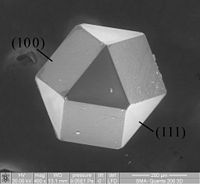
Highly Conductive Transition Metal Carbide/Carbonitride(MXene)@polystyrene Nanocomposites Fabricated by Electrostatic Assembly for Highly Efficient Electromagnetic Interference Shielding
Sign Up to like & getrecommendations! Published in 2017 at "Advanced Functional Materials"
DOI: 10.1002/adfm.201702807
Abstract: Highly conductive polymer nanocomposites are greatly desired for electromagnetic interference (EMI) shielding applications. Although transition metal carbide/carbonitride (MXene) has shown its huge potential for producing highly conductive films and bulk materials, it still remains a… read more here.
Keywords: mxene polystyrene; highly conductive; conductive polymer; polystyrene ... See more keywords

Structure and Properties of Microwave Transparent Crosslinked Polystyrene Prepared through 3D Printing Bulk Polymerization
Sign Up to like & getrecommendations! Published in 2017 at "Journal of Applied Polymer Science"
DOI: 10.1002/app.44865
Abstract: Polystyrene (PS) crosslinked with divinylbenzene is one of the most promising microwave (MW) transparent polymers for structural application. However, preparation of it has been always inhibited by severe thermal runaway. Under this background, novel technology… read more here.
Keywords: microwave transparent; bulk polymerization; polymerization; polystyrene ... See more keywords

Ingestion and Toxicity of Polystyrene Microplastics in Freshwater Bivalves.
Sign Up to like & getrecommendations! Published in 2021 at "Environmental toxicology and chemistry"
DOI: 10.1002/etc.5076
Abstract: The ubiquity of microplastics in aquatic ecosystems has raised concerns over their interaction with biota. However, microplastics research on freshwater species, especially molluscs, is still scarce. We, therefore, investigated the factors affecting microplastics ingestion in… read more here.
Keywords: microplastics freshwater; polystyrene microplastics; toxicity polystyrene; toxicity ... See more keywords

Interaction of polystyrene nanoparticles with supported lipid bilayers: Impact of nanoparticle size and protein corona.
Sign Up to like & getrecommendations! Published in 2023 at "Macromolecular bioscience"
DOI: 10.1002/mabi.202200464
Abstract: Polystyrene is one of the most widely used plastics. Here we report on the interaction of 50 nm- and 210 nm polystyrene nanoparticles (PSNPs) with human serum albumin and transferrin, as well as their effect on supported… read more here.
Keywords: interaction; supported lipid; nanoparticle size; polystyrene ... See more keywords

Grafting polystyrene with various graft densities through epoxy groups of graphene nanolayers via atom transfer radical polymerization
Sign Up to like & getrecommendations! Published in 2017 at "Polymer Composites"
DOI: 10.1002/pc.23832
Abstract: A double bond and amine group containing chemical (OD) was synthesized by coupling reaction of ethylenediamine and 3-(chlorodimethylsilyl)propyl methacrylate. Subsequently, graphene oxide (GO) was functionalized with OD in different densities via ring opening of its… read more here.
Keywords: atom transfer; groups graphene; radical polymerization; transfer radical ... See more keywords

Assessing the binding interaction of polystyrene sulfonate with amitriptyline in healthy volunteers: a cross-over design - The BIND study.
Sign Up to like & getrecommendations! Published in 2022 at "European journal of clinical pharmacology"
DOI: 10.1007/s00228-022-03283-5
Abstract: PURPOSE Polystyrene sulfonate is used for binding potassium in patients with chronic kidney disease (CKD). Because of its binding properties, it can potentially bind other medications and thereby decrease their bioavailability and effectiveness. Amitriptyline, often… read more here.
Keywords: polystyrene sulfonate; sulfonate amitriptyline; polystyrene; healthy volunteers ... See more keywords

Mesoporous TiO2 from poly(N,N-dimethylacrylamide)-b-polystyrene block copolymers for long-term acetaldehyde photodegradation
Sign Up to like & getrecommendations! Published in 2019 at "Journal of Materials Science"
DOI: 10.1007/s10853-019-04024-3
Abstract: Although already some mesoporous (2–50 nm) sol–gel TiO2 synthesis strategies exist, no pore size control beyond the 12 nm range is possible without using specialized organic structure-directing agents synthetized via controlled anionic/radical polymerizations. Here, we… read more here.
Keywords: tio2; block; poly dimethylacrylamide; structure directing ... See more keywords

Evaluation of the use of polyphosphates as photostabilizers and in the formation of ball-like polystyrene materials
Sign Up to like & getrecommendations! Published in 2019 at "Journal of Polymer Research"
DOI: 10.1007/s10965-019-1829-y
Abstract: Polyphosphates have been used as polystyrene photostabilizers against ultraviolet irradiation for long period. The efficiency of polyphosphates was herein evaluated by the use various techniques that include determination of the weight loss, average molecular weight,… read more here.
Keywords: microscopy; polystyrene films; ball like; evaluation use ... See more keywords

Development of Bulk Lightweight Spherosilicate Material Technology Based on Sublimation of Expanded Polystyrene Granules
Sign Up to like & getrecommendations! Published in 2020 at "Refractories and Industrial Ceramics"
DOI: 10.1007/s11148-020-00389-0
Abstract: The paper discusses the technology for producing bulk lightweight spherosilicate materials as an alternative to expanded vermiculite-based thermal insulation products. The technology is based on the idea of using granulated expanded polystyrene to create a… read more here.
Keywords: bulk lightweight; lightweight spherosilicate; technology based; polystyrene ... See more keywords

Arsenate removal from underground water by polystyrene-confined hydrated ferric oxide (HFO) nanoparticles:effect of humic acid
Sign Up to like & getrecommendations! Published in 2019 at "Environmental Science and Pollution Research"
DOI: 10.1007/s11356-019-07282-5
Abstract: Arsenic decontamination from groundwater is an urgent but still challenging task. Polystyrene-based hydrated ferric oxide (denoted as D201-HFO) nanocomposite is a new emerging current adsorbent for efficient arsenate removal in natural waters; the resulting materials… read more here.
Keywords: polystyrene; ferric oxide; hydrated ferric; arsenate removal ... See more keywords

Combined polystyrene microplastics and chlorpyrifos decrease levels of nutritional parameters in muscle of rainbow trout (Oncorhynchus mykiss)
Sign Up to like & getrecommendations! Published in 2021 at "Environmental Science and Pollution Research"
DOI: 10.1007/s11356-021-15536-4
Abstract: Microplastic (MP) is a major contaminant in the aquatic environment. In addition to the physical threats posed by microplastic ingestion, their potential as a vector for the transport of hydrophobic pollutants is required to be… read more here.
Keywords: muscle rainbow; polystyrene microplastics; parameters muscle; nutritional parameters ... See more keywords